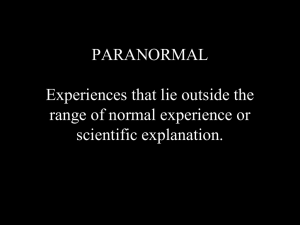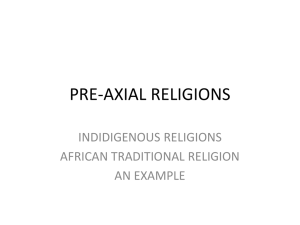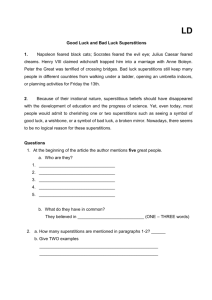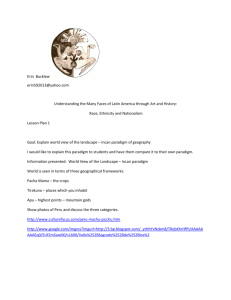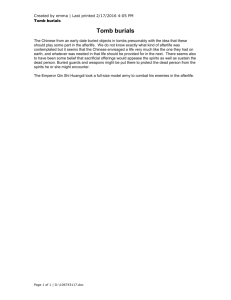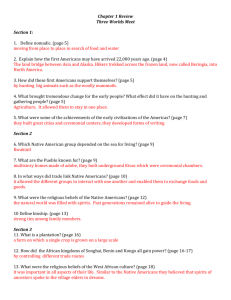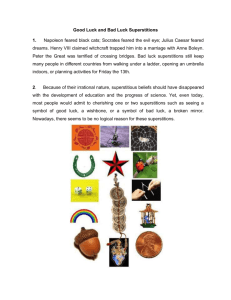Trends in the Spirits Industry
advertisement
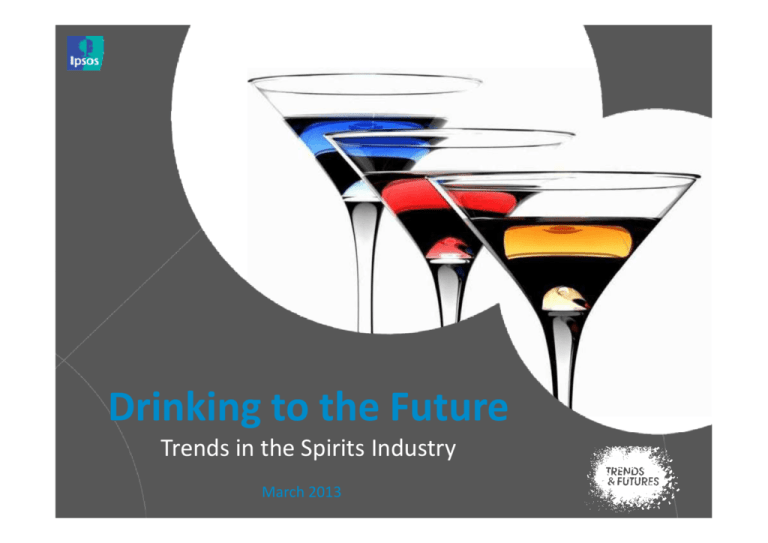
Drinking to the Future Trends in the Spirits Industry March 2013 WHAT’S IN THIS REPORT? Spirits Trends – the Global Context Innovation Advertising & Digital Marketing Premiumisation & Craft Changing drinking behaviours & regulation IF YOU ONLY HAVE A MINUTE… • Emerging markets are becoming increasingly important as consumers of spirits and imported brands are growing rapidly, being now key markets for the global spirits industry • Despite the weak global economy, premium and superpremium brands are growing thanks to a focus on provenance and aspirational consumers • Social media provides an excellent opportunity for alcohol retailers to connect with consumers. There are innovative social media campaigns going on – but interaction doesn't necessarily lead to engagement • Minimum pricing could be enacted in the UK, it’s already law in Scotland. Britain still loves spirits but drinking demographics are changing - young people now drink less than their elders 3 THE SPIRITS INDUSTRY - 2013 Overall, the future looks positive for the global spirits industry. According to latest full year data, the global spirits market expanded by 7% in volume between 2010 & 2011. Thanks to premiumisation, growth in market value is outstripping volume. The industry experienced 10% growth in sales value over the same period. However moving forward the spirits industry faces a number of challenges, such as regulation. 4 SPIRITS TRENDS: THE GLOBAL CONTEXT In the US, New York & LA are setting trends which resonate globally. Lowcalorie spirits, rye whiskey and food in cocktails are ones to watch. SPIRITS TRENDS: THE GLOBAL CONTEXT In the UK there is an increasing interest in cocktails: with consumption to grow by over 10% in the next 2 years. Minimum pricing per unit likely to be enacted soon. Source: IWSR Volume Data, UK Government ONS China, Russia and India all have one thing in common – imported spirits are an expanding category. Sales have grown by 250% in China over the last 10 years. Brazil’s passion for whisky shows no signs of abating. Exports of scotch have increased by 50% and whisky is now the UK’s sixth largest export to the country 5 SPIRITS TRENDS IN CHINA Per capita alcohol consumption in China is increasing rapidly, meaning that growth in the size of the Chinese spirits market is outstripping both the economy and natural population growth Baijiu (white spirit) & rice wine are by far the most popular alcoholic drinks in China, whilst imported spirits are still only a fraction of the total market. Cognac & blended scotch are the biggest selling imported spirits, closely followed by vodka. In 2012 total sales of imported spirits in China were 250% higher than 2001, and 16% higher than 2011 – this is faster growth than in any other market. The Chinese use premium spirits brands to flaunt wealth. In China the top 3 imported brands dominate the market – with a total share of 43% in 2011 Source: The Guardian, World Health Organisation 2011, IWSR volume data, 2012 SPIRITS TRENDS IN INDIA The regulatory environment for alcohol in India has changed a great deal in the last two years. Sale of alcohol has been banned in various places, including bus stops, open markets, railway stations, petrol stations and airports. •Alcohol advertising has been banned, along with drinking in public places. Hours of trading have been limited, prohibiting the sale of alcohol between 11pm and 8am. •However, Indian imported spirits are growing 25% yearly and it is estimated that Indian spirit imports will soar to five million cases by 2015, says •88% of alcohol consumption in India is spirits, while 10% comes from beer and only 2% from wine. •Whisky remains the most widely consumed imported spirit in India. A minimum price has recently been placed on vodka, doubling the price of the cheapest brands. •Rum has potential to attract new drinkers, being the drink of choice for young adults who wish to seem rebellious. In 2011 UB Group became the second largest spirits producer globally... ...99% of UB’s spirit sales come from India Source: Warc (2006), Mintel (2011), Euromonitor (2012), IWSR (2012 , Associated Chambers of Commerce and Industry of India 7 SPIRITS TRENDS IN BRAZIL Brazil is one of the biggest markets for spirits; the city of Recife in Brazil is believed to have the highest per capita consumption of whisky in the world. The drinks industry in Brazil, along with many other developing markets, is premiumising rapidly. This has contributed to the incredible boom of global whisky sales in recent years, particularly for Diageo’s Johnnie Walker. In the last few years exports of scotch whisky to Brazil were up nearly 50%, and according the Scotch Whisky Association (SWA). Whisky is now the UK's sixth largest export to Brazil. Recently, the premiumisation trend has scaled up to Champagne consumption. Alexis Petit-Gas, marketing director at Canard-Gats, described it as “one of the hottest countries at the moment” and Dom Pérignon’s impressive growth in 2011 came from South America, primarily Brazil. A high proportion of alcohol consumption occurs at home in Brazil Sources: Survey conducted by Brazil’s National Anti-drug Secretariat (SENAD), 2007 Luxury society http://luxurysociety.com - BRICS: The Future of Champagne? – 2012 IWSR Volume Data, 2012 & UK Government Bars: 27% Home 23% Parties/events: 17% Relative’s home: 3% Other: 30% 43% drink in someone’s home, not in commercial establishments 8 SPIRITS TRENDS IN RUSSIA The Russian spirit market has traditionally been dominated by vodka. There is more vodka consumed in Russia than in any other country in the world. The Russian market is responsible for 45% of global vodka consumption. Vodka makes up 87% of Russian spirits sales, and it is estimated that Russian consumers drink an average of thirty bottles of vodka each year. However vodka’s dominance may be under threat. Vodka sales in Russia have fallen nearly 30% over the past decade. Meanwhile, from 2005-10 the Russian wine market grew by a third (from $5.1bn to $7.8bn) and their beer market more than doubled in size from $10bn to over $20bn. Vodka’s decline is reflected in an overall fall in alcohol sales of 15% from 20092011, largely blamed on increased regulation. Recent Russian regulation includes doubling the price of cheap vodka, a 200% tax increase on beer, and a ban on alcohol advertising. Sources: Euromonitor, 2011; International Markets Bureau, 2012; BBC News, 2011; International Markets Bureau, 2011; IWSR, 2011; Guardian, 2010; Reuters, 2012 SPIRITS TRENDS IN THE US US consumers are increasingly concerned about the effects of excessive drinking on both health and personal appearance. As a result, ‘Skinny’ or low-calorie pre-mixed cocktails are growing rapidly in the ready to drink (RTD) category. Young women are the demographic driving RTD growth in the US. Our research shows that women are both more likely than men to consider pre-mixed cocktails and to be concerned about health and personal appearance. Alongside the skinny trend, low alcohol cocktails, wines and RTD variants are taking off in the United States. In general, US consumers are looking for lighter alternatives. Beam’s ‘Skinnygirl’ brand grew by 388% in volume between 2010 and 2011 “I like cocktails so much that sometimes I wish all booze was lower in proof because I want to drink more and not feel (the) effects as intensely” - Female US Consumer Huffington Post/Technomic, 2012, Ipsos MORI 2012, Shanken News Daily 2012, San Francisco Chronicle, 2010 & IWSR, 2012 SPIRITS TRENDS IN THE US (cont’d) In the US, rye whiskey is back on the bar. By the 1970s, rye whiskey production had fallen to almost zero outside of the American South. It was rediscovered in the 2000s by bartenders & mixologists. Consumption of rye whiskey in the US has taken off. Most rye whiskey is either exported or consumed in cities like New York or LA as a cocktail ingredient. It’s not just the craft segment that’s leading rye production. Major companies like Jim Beam now produce rye on a large scale. Recently, methods from the food industry have started to enter bars in New York. Mixologists have begun to use various food ingredients in cocktails – experimenting with combinations like fruit and Thai curry paste. New York Times, 2011 & 2012, Food & Wine Blog, New Yorker Magazine, Shanken News Daily INNOVATION All of the major producers are innovating, redefining and creating new categories in the spirits industry • In the US, flavours are the fastest growing part of the vodka category •Mixed-category variants have started to appear, with different spirits combined in the same product •Packaging has evolved, increasing consumer convenience 12 Product innovation in spirits continues to focus on a proliferation of flavours... ...aimed at attracting new consumers In the US, the flavoured vodka category expanded by 25% between 2010 and 2011 Source: IWSR Volume data 2012 Major companies are introducing ‘mixed category’ variants, combining different spirits in one bottle Pernod Ricard launched Malibu Red in the US in March 2012. According the NABCA, the brand sold 13,000 9-litre cases in ‘control states’* from March to October 2012. Control states usually account for a third of a brand’s sales, meaning Red is performing strongly in-market *control states, are 18 states in the United States that have state monopoly over the wholesaling and/or retailing of some or all categories of alcoholic beverages, such as beer, wine and distilled spirits. Source: Shanken News Daily, December 13 2012 Packaging has become more advanced, focusing on practicality... ...ready-to drink mixed cans and pouches allow for greater convenience for the consumer •Growth in off-trade consumption (drinking at home) has driven sales of higher-strength pre-mixed cans •RTDs allow consumers to emulate the out-of-home drinking experience at a lower price point •Spain and the United Kingdom are key growth markets for RTDs in Western Europe •As the economic environment in Western Europe remains unstable, further growth in the category can be expected Source: Euromonitor passport, Alcoholic Drinks in 2011 ADVERTISING & DIGITAL MARKETING Spirit brands are making strides - finding ways to exploit the opportunity that social media represents •Brands are changing the tone and content of advertising to better resonate with consumers •Smirnoff, Bacardi and ABSOLUT are innovating and succeeding by using apps and global dance competitions... • …and continuing efforts to promote responsible drinking 16 Our research shows spirits advertising is evolving, with major brands adopting new approaches Aspirational advertising is still important for super-premium brands. Along with provenance, we are seeing a trend towards excitement and (as in other categories), greater emotional engagement in drinks advertising. Source: Ipsos MORI tracking data 17 Spirits advertising has long focused on conveying quality by leveraging brand heritage... ...but more and more brands are identifying with and relating to things drinkers care about Jack Daniel’s quality message has recently taken a more creative and humoristic tone. Global brands are becoming increasingly adept at adapting big ideas to the local market context 18 There are key reasons why consumers interact online with spirit brands... 31-34% 45-48% Wanted to let others know what they thought of a brand interact online to let friends know they like the brand 21-26% 12-15% Wanted to let the brand know that they like it! Wanted to get something free... Source: Mintel (2012) White Spirits & RTDs: There is some variation between brands: these scores apply for Bacardi, Smirnoff and ABSOLUT only ABSOLUT and Bacardi have been praised for innovative social media marketing strategies ... has developed a smart micro-site and mobile app which allows users to search for cocktails and gives a step-by-step guide on how to make the drink Source: Media Post (2013) .... has recently begun a partnership with Spotify, started to experiment with QR codes and created a mobile app Mix Master Smirnoff has quickly adopted innovative strategies in digital marketing… • In 2012, Smirnoff held a global tour of events and parties named ‘Midnight Circus’ • At one event consumers had their movements tracked and posted directly to Facebook with a digital bracelet The event... • Included 2,400 guests • Created 4,000 “likes“ • Posted 8,000 photos • Reached 800,000 friends Source: Warc - How a social media and experiential strategy renewed Diageo’s vodka brand, 2012 …by successfully fusing campaign activation with digital for a powerful, integrated message • In 2011, Smirnoff held a global dance competition called ‘Nightlife Exchange’, celebrating dance culture around the world • They joined up with Madonna to find a dancer to join her 2012 tour... • Achieving 1 billion press impressions worldwide. • Increasing their share of voice by 30% • Garnering 5,000 Facebook likes for Smirnoff cocktails Source: Splendid Communications, 2012 However influential brands still face challenges in leveraging social media We need to respect digital the same way we used to respect television advertising…. Ultimately, consumers 'liking' a brand is not a true sign of engagement. Michelle Klein Vice President in Content, Digital & Communications Smirnoff – Diageo 23 Major companies are launching innovative responsible drinking campaigns Bacardi, Diageo and Pernod Ricard have recently launched a campaign promoting responsible practices on social media They have each committed to.... • Remove inappropriate user-generated content from brand pages within 48 hours • Restrict Facebook users under 18 from accessing alcohol brand pages Bacardi has teamed up with global tennis superstar Rafael Nadal to say that ‘champions drink responsibly’ Source: Brand Channel, 2012 PREMIUMISATION Premium spirits brands are growing despite a lack of economic growth in developed markets... • By providing consumers with affordable luxury • Expanding the reach of craft producers • And redefining the spirits category with super-premium brands 25 The premium spirits category grew faster than standard spirits in 2011 The value of the premium spirits category increased by 21% in 2011 worldwide, whilst standard spirits grew by only 12% • The BRIC markets (Brazil, Russia, China and India) are the engine of growth in the premium spirits category. Premium imported spirits grew by 16% in China between 2010 and 2011 • The super-premium sector grew by 24% in the BRICs as a whole between 2010 and 2011 • Whisky and Cognac are the key drivers of growth in the premium category worldwide, growth which shows no signs of abating Source: IWSR Sales Data & World Bank, 2012 26 The top five premium brands all achieved sales growth in 2012 4,0 3,0 Bn. £ Sales Value - Top 5 Premium Spirits Brands 2011 2012 2,0 1,0 0,0 The premium spirits category is defined by the IWSR as spirits with a retail value of $20 and above Source: IWSR Sales Data, 2012 27 Consumers want to ‘trade up’ and satisfy higher needs Consumers increasingly desire the success and selfactualisation that premium brands symbolise Premiumisation is a journey for the consumer “the gradual progression from satisfaction of basic needs to higher ones” Source: Mintel – Premiumisation, 2012 28 Value is key for purchase of premium products Consumers are seeking affordable luxury Spirits premiumisation is happening because consumers are increasingly searching for value for money from purchases around the world 88% of consumers consider spirits an affordable luxury To consumers, affordable luxury means quality Consumers regard them as “worth & value paying more for” Neilsen – Ongoing Consumer Confidence Survey & Ipsos MORI Research: 2009 - Present 29 What do spirits brands need to do to be seen as premium? Brands must score well on certain criteria to be seen as premium: provenance and excitement are essential attributes Our Learnings Has the best taste Is worth paying more for Has perfection in every detail PREMIUM EQUITY Is a brand that excites me Makes me look and feel my best Provenance is certainly helping premium craft producers to grow 61% % Worldwide growth in sales value 2011 vs. 2012, Tito’s Handmade Vodka Ipsos MORI Research: 2009 - Present 30 Distillery Registrations – Association of America & IWSR Sales Data It’s not all about craft – the super premium phenomenon is reinvigorating spirits Between 2006 and 2011, standard gin sales stagnated whilst super-premium gin sales grew 18% Source WARC 2012 31 As a luxury purchase, super-premium spirits must stand out from the crowd Effective marketing through celebrity endorsement helps reach aspirational consumers Ciroc’s sales by value have increased by over 1000% since 2007, driven by a global marketing partnership with P Diddy Source: IWSR Sales Data 32 BRITISH DRINKING BEHAVIOUR In November 2011, Ipsos MORI & Drinkaware conducted national research into British drinking behaviour Our research confirmed that there are major differences in drinking behaviour among males, females and key age groups in Britain. Young women are more likely than young men to drink irresponsibly One key trend emerged - young British adults are increasingly turning to off-trade consumption in the current economic climate 33 Our research shows that British male and female consumers have different reasons for drinking Men and women give different reasons for getting drunk Women are less likely to feel pressure to drink, but twice as likely to say that drinking gives them confidence. Women are 50% more likely to drink to get drunk, and twice as likely to get drunk unintentionally Young women are also a third more likely than young men to binge drink In other words, men drink from social pressure, women drink for social confidence Source: Ipsos MORI/Drinkaware, 2012 Drinking is increasing, 1 in 10 adults admit they can’t go a day without a drink Half of consumers think the worst British national characteristic is drinking culture British alcohol consumption has more than doubled since 1950 Sources: Ipsos MORI/Channel 4, 2012; British Beer and Pub Statistical Handbook, 2010; Bupa, 2011 However, young adults in the UK now drink less than older consumers 47% of 18-24 year-olds in the United Kingdom are regular drinkers, versus 67% of 25-44 year-olds The number of underage drinkers and the age at which people have their first drink has fallen consistently across the United Kingdom over the last ten years Sources: Ipsos MORI/Drinkaware, 2012; Statistics on Alcohol in England, 2012; Ipsos MORI/SALSUS, 2010; BMA, 2003; Hibell et al, 2009 Our research shows young adults are increasingly drinking at home, then going out... ...this is known as ‘pre-loading’ • Pre-loaders drink on average 75% more on a night out than non-preloaders. • The excess is not just down to the pre-loading; they also drink more on the night out itself •One in five young people say they pre-loaded on their last night out • It’s not just heavy drinkers – occasional drinkers are just as likely to pre-load • This implies that for many, pre-loading is the norm Pre-loading is an established part of a night out Source: Ipsos MORI/Drinkaware, 2012 Half of young adults now celebrate special occasions at home rather than going out Young people may have been forced to drink more at home in times of austerity, but it appears they have decided that home is the place to be Over half of 18-24 year-olds drink at home for a special occasion - compared with just four in ten of overall UK off-trade drinkers. A fifth also claim to be entertaining at home now more than ever Source: Mintel, 2011 - http://www.mintel.com/press-centre/press-releases/737/drinking-at-homeis-the-toast-of-the-town-for-18-24-year-olds-half-now-celebrate-special-occasions-at-home Almost eight in ten (79%) consumers have drunk alcohol at home in the last six months 76% It’s cheaper Price is why young adults are turning to the off trade 27% More intimate 30% Crowded bars 35% Less hassle REGULATION Although the trend is far from universal, the drinks industry faces the prospect of increased regulation in key markets • In the 2000s, the UK drinks industry was increasingly deregulated, but the situation is changing • Although latest news suggest that the plan to implement minimum pricing might not be enacted in the wider UK responses to the government’s consultation are still being considered. Scotland has already passed a 50p minimum price per unit A consultation was undertaken earlier this year by the UK government on a new law enforcing a minimum cost of 45p per unit in England & Wales 45p per unit would mean... Strength 12.5% 750ml Strength 7.9% 440ml Strength 8.4% 440ml Strong Lager £1.56 Strong Cider £1.66 Wine £4.22 Strength 40% 700ml Whisky £12.60 Strength 37.5% 1 litre Vodka £16.88 However, Treasury officials are said to be against it on the grounds that it would reduce tax revenues at a time when the economy is under stress http://www.telegraph.co.uk/news/politics/9926045/David-Cameron-abandons-plans-for-minimum-alcohol-price.html The new law could cause an estimated 4-5% drop in alcohol consumption Over ten years, this would result in: •2,000 fewer deaths •66,000 less hospital admissions •240,000 less crime cases Source: University of Sheffield, 2010 However, there is little public appetite for this change, few English people think it will work Just one in six English people who wish to reduce their drinking thought minimum pricing would help, however One in five thought advice and support from a GP would be more useful One in four thought more information about safe levels of consumption on packaging would make the biggest difference Source: Ipsos MORI/East of England Public Health Group, 2009 And for beer, the government appears to be going in the opposite direction In the Budget, George Osborne announced that the beer tax escalator would be scrapped, which had automatically increased beer duty at 2% above inflation every year since 2008 – and reduced existing beer duty by a penny. However, the escalator remains in place for wines and spirits. This was lauded by the beer industry, but condemned by the Wine and Spirit Trade Association, who said: “If this was designed as a measure to support pubs it seems misplaced: over 41% of drinks sold in pubs are wine and spirits, contributing £9.4bn per year.” Source: http://www.guardian.co.uk/lifeandstyle/2013/mar/20/chancellor-scraps-beer-duty CONCLUSIONS Conclusions The spirits industry is healthy and growing, but faces increasing challenges from the economic climate in key markets. Developed countries will not grow rapidly in the near future, meaning that emerging markets are key to driving growth in the global industry. Producers are responding to a fragmenting global market with new innovations, creating and reinventing categories to boost growth in both volume and value Drinks advertising and marketing is changing, with new approaches to traditional methods and social media increasingly important The industry as a whole is premiumising, as consumers look to spend more to get better value from what they buy. Provenance is increasingly important and driving the growth of the craft sector Drinking behaviour is changing across the generations, with differences emerging between younger and older adults Learnings from our research Building successful brands in the spirits industry requires time and investment. The industry has never been more fragmented or dynamic, with new brands and categories quickly building awareness and loyalty: • • • • Leveraging brand heritage and focusing on quality are effective in all spirits advertising, but humour and creativity are increasingly necessary to stand out. Aspirational advertising is still important for super-premium brands. Celebrity endorsement and provenance will build premium perceptions Global brands are becoming increasingly adept at adapting big ideas to the local market context. With the increasingly competitive and fragmented global market, the need for packaging to differentiate brands has continued apace Brands which identify themselves with a clear consumption occasions continue to enjoy success. For more information, contact: ines.nadal@ipsos.com gareth.jones@ipsos.com marcus.reidy@ipsos.com isabel.preza@ipsos.com freya.benson@ipsos.com harry.carr@ipsos.com
